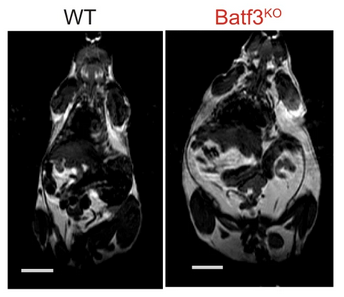Elena Hernández-García, Francisco J. Cueto, Emma C. L. Cook, Ana Redondo-Urzainqui, Sara Charro-Zanca, Iñaki Robles-Vera, Ruth Conde-Garrosa, Ivana Nikolić, Guadalupe Sabio, David Sancho & Salvador Iborra.
Conventional dendritic cells (cDCs) scan and integrate environmental cues in almost every tissue, including exogenous metabolic signals. While cDCs are critical in maintaining immune balance, their role in preserving energy homeostasis is unclear.
Here, we showed that Batf3-deficient mice lacking conventional type 1 DCs (cDC1s) had increased body weight and adiposity during aging. This led to impaired energy expenditure and glucose tolerance, insulin resistance, dyslipidemia, and liver steatosis. cDC1 deficiency caused adipose tissue inflammation that was preceded by a paucity of NK1.1+ invariant NKT (iNKT) cells. Accordingly, among antigen-presenting cells, cDC1s exhibited notable induction of IFN-γ production by iNKT cells, which plays a metabolically protective role in lean adipose tissue. Flt3L treatment, which expands the dendritic cell (DC) compartment, mitigated diet-induced obesity and hyperlipidemia in a Batf3-dependent manner. This effect was partially mediated by NK1.1+ cells.
These results reveal a new critical role for the cDC1-iNKT cell axis in the regulation of adipose tissue homeostasis.






